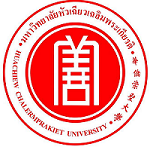Please use this identifier to cite or link to this item:
https://has.hcu.ac.th/jspui/handle/123456789/878| Title: | 汉泰形状量词对比探析 |
| Other Titles: | วิเคราะห์ลักษณะนามบอกรูปทรงภาษาจีนและภาษาไทย Classifier Analysis to Identify Shapes in Chinese and Thai |
| Authors: | 李超 Li, Chao 肖丹 เพ็ญยุภา นุกูล Penyupa Nukoon Huachiew Chalermprakiet University. College of Chinese Studies |
| Keywords: | ภาษาจีน -- การศึกษาและการสอน Chinese language -- Study and teaching 汉语 -- 学习和教学 ภาษาไทย -- ลักษณนาม Thai language -- Classifiers 比较语言学 ภาษาจีน -- ลักษณนาม Chinese language -- Classifiers 汉语 -- 名词 ภาษาศาสตร์เปรียบเทียบ 比较语言学 รูปทรง -- ลักษณนาม Shapes -- Classifiers |
| Issue Date: | 2019 |
| Publisher: | Huachiew Chalermprakiet University |
| Abstract: | เป็นที่รู้จักกันดีว่า ประเทศไทยนั้นหลายโรงเรียนได้มีการสอนวิชาภาษาจีนและทุกคนก็ให้ความสำคัญกับวิชาภาษาจีนนี้ ซึ่งในประเทศไทยตอนนี้ได้มีการเปิดสอนภาษาจีนตั้งแต่ชั้นอนุบาล ประถมต้น ประถมปลาย มัธยมต้น มัธยมปลาย ถึงมหาวิทยาลัย ภาษาจีนจึงไม่ได้เป็นแค่วิชาเล็กๆ แต่เป็นวิชาที่สำคัญวิชาหนึ่ง วิชาภาษาจีนได้มีการเปิดสอนมาเป็นเวลานาน ซึ่งในปัจจุบันนี้หลายโรงเรียนก็จะพบปัญหาการเรียนการสอนที่หลากหลาย เช่น นักเรียนไม่เข้าใจความหมายของคำศัพท์ ใช้ไวยากรณ์ผิดออกเสียงที่ไม่ถูกต้อง ลักษณนามใช้ไม่ถูกต้อง โดยเฉพาะอย่างยิ่่งในการใช้ลักษณนามนี้ จีนและไทยมีลักษณนามมากมายหลากหลาย เพราะว่ามีมากมายนั้น ในบางครั้งจึงทำให้เกิดปัญหาใช้ไม่ถูกต้องหรือนักเรียนเองยังขาดความรู้ทางด้านลักษณนาม เช่น การใช้ลักษณนามจีน นำภาษาจีนแปลเป็นภาษาไทยตรงตัว โดยที่แท้จริงแล้วลักษณนามคำนั้นอาจจะไม่ได้ใช้คู่กับคำนามตัวนี้ก็ได้ อย่างนี้้ จึงทำให้นักเรียนนั้นใช้ลักษณนามจีนผิดพลาดกันมาก โดยเฉพาะอย่างยิ่งกับลักษณนามบอกรูปทรง เนื่องจากบอกรูปทรงคล้ายคลึงกัน รวมทั้งการที่นักเรียนไทยใช้ภาษาไทยเป็นภาษาหลักจะส่งผลกระทบให้นักเรียนเข้าใจในลักษณนามจีน-ไทยได้ยากมากขึ้น ดังนั้นผู้วิจัยจึงเลือกนำลักษณนามบอกรูปทรงจีนไทยสองภาษานี้มาศึกษาเปรียบเทียบ ผู้วิจัยได้วิจัยเรื่องการเปรียบเทียบลักษณนามบอกรูปทรงของภาษาจีนและภาษาไทย โดยแบ่งออกเป็น 6 บท คือ บทนำ แบ่งประเภทลักษณนามบอกรูปทรงจีนไทย การเปรียบเทียบลักษณนามบอกรูปทรงกลมรีจีนไทย การเปรียบเทียบลักษณนามบอกรูปทรงยาวจีนไทย การเปรียบเทียบลักษณนามบอกรูปทรงแผ่นจีไทย การเปรียบเทียบลักษณนามบอกรูปทรงก้อนจีนไทย และปัญหาในการเรียนลักษณนามบอกรูปทรงของนักเรียนไทยพร้อมวิธีการสอน และข้อเสนอแนะ It is well-known that many schools in Thailand teach Chinese and everyone pays attention to Chinese subjects. At present, Thailand offers Chinese language education for students in kindergarten, elementary education, junior high school, senior high school, and university. Chinese subject is not just a small subject, it is an important subject. There is an instruction for Chinese subject for a long time. Nowadays, many schools encounter various problems in learning and teaching Chinese subject. For example, students do not understand the meaning of vocabulary, they use the wrong grammar, they pronounce incorrectly and especially they use the classifier incorrectly because Chinese and Thai language have many classifiers. Due to the large number of classifiers, it is sometimes a problem because of incorrect use. The students themselved lack knowledge of classifier. For example, when using Chinese classifiers, they translate Chinese into Thai directly. In fact, the classifier may not be used with that noun. As a result, the students use Chinese classifiers very wrongly, especially with classifiers to identify shapes because the shape identifying is similar. Moreover, Thai students are more difficult to understand the Chinese-Thai classifier because they use Thai as their primary language. Therefore, the researchers studied and compared the classifier to identify the shape in Chinese and Thai languages. So the researcher has studied the comparison of the classifier to identify the shaped of Chinese and Thai languages. The research is divided into 6 chapters which are introduction, classfication of classifiers to identify shapes in Chinese and Thai, comparison of classifiers to identify sphere in Chinese and Thai, comparison of classifiers to identify long shape in Chinese and Thai, comparison of classifiers to identify sheet shape in Chinese and Thai, comparison of classifiers to identify cube shape in Chinese and Thai, and problems in learning classifier to identify the shape of Thai students, along with teaching methods and suggestions. 众所周知,现在泰国整个国家,很多学校都开设了汉语课,也都很注重汉语这门课。从幼儿园、小学、初中、高中甚至到大学都有开设汉语课程。所以汉语不是一门可有可无的课,而是一门很重要的课。 在汉语教学中,很多学校都会碰到各种各样的教学问题,比如:学生不理解生词的意义、发音不标准、运用的语法不对等,尤其是量词方面存在很多问题,泰国与中国都是量词丰富的国家,由于学生自己量词方面的知识还不够全面、不能准确把握泰汉量词之间的区别,直接把泰语量词套用到汉语量词上,但是它们可能存在名词搭配的差异,这样学生就容易犯错误。尤其是与形状相关的量词最容易搞混,加上母语负迁移的情况,学生就很难对量词有准确地把握。 因此,本文就选择了两个国家有关形状量词方面的内容来进行研究比较。 本文将把两种语言相关的形状量词分为四类进行比较研究有点状、条状、面状与体状。然后收集量词的意义,分析对比找出它们的异同。在此基础上,收集学生经常使用错误的量词来分析并提出相应的教学方法与建议。本文共分为六章;汉泰语形状量词分类,汉泰点状形状量词对比分析,汉泰线状形状量词对比分析,汉泰面状形状量词对比分析,汉泰体状形状量词对比分析与泰国学生学习汉语形状量词的偏误分析与教学建议。 形状 -- 名词 |
| Description: | Thesis (M.A.) (Teaching Chinese) -- Huachiew Chalermprakiet University, 2019 |
| URI: | https://has.hcu.ac.th/jspui/handle/123456789/878 |
| Appears in Collections: | College Of Chinese Studies - Theses |
Files in This Item:
| File | Description | Size | Format | |
|---|---|---|---|---|
| PENYUPA-NUKOON.pdf Restricted Access | 1.99 MB | Adobe PDF | View/Open Request a copy |
Items in DSpace are protected by copyright, with all rights reserved, unless otherwise indicated.
